Binary Options News Trading: How Events Affect Expiry Results

When I first heard about binary options news trading, I thought I’d cracked the code. Big news makes markets move, so why not just trade that movement? I imagined myself reacting instantly to data releases, catching the early momentum, and closing the laptop with easy wins. Reality didn’t quite match that picture.
Those first few weeks were rough. The charts did move, but not always in the direction I expected, or at least, not for long enough. That’s when I started paying attention to something I’d been ignoring: expiry timing. It’s one thing to predict direction; it’s another to align it with how long the move lasts. That small detail changed everything.
If you’re curious to see how timing shapes real results, you can open an account on Pocket Option and experiment on a demo first. It’s the best way to experience how fast or slow, markets react around news.
How I Stumbled Into News-Driven Trades
I still remember the first “news trade” I ever made. It was during the U.S. Non-Farm Payrolls (NFP) release, a classic high-volatility event. The forecast called for 170,000 new jobs. I thought, “If the number’s weaker, stocks will drop, and I’ll take a ‘down’ binary.”
The number came out at 145,000. Bad for the economy, right? Stocks should fall. Except they didn’t. Within seconds, prices spiked upward. My trade expired out of the money before I even processed what had happened.
Later I realized: the market had already priced in worse expectations. The data wasn’t great, but it was less bad than feared. The real movement wasn’t about the number, it was about surprise versus forecast.
That one trade taught me something no indicator ever had: trading the news isn’t just reacting to headlines. It’s about understanding what the market expected before the news hit, and how that expectation shapes expiry results.
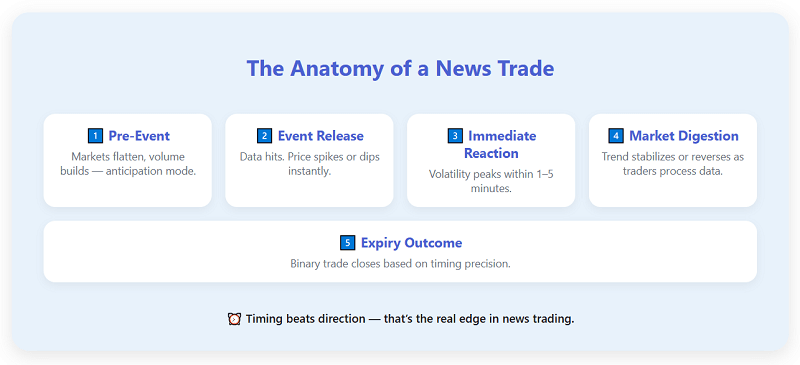
What Binary Options News Trading Actually Means to Me
Over time, I came to define binary options news trading in my own words. It’s not just betting on a chart spike after a news release. It’s aligning three moving parts:
- The event itself (like inflation data, rate decisions, or earnings reports).
- The market expectation ahead of it.
- The expiry window, how long I think that reaction will last.
Most guides stop after the first point, maybe mention “volatility” once, and move on. But the expiry is where most traders quietly lose money. It’s not whether you’re right about direction, it’s whether your trade expires during the profitable part of the move.
If you’ve ever been right about a move but still lost because your trade expired too soon or too late, you already know how critical timing is.
My Early Mistakes
Looking back, my first dozen trades read like a checklist of what not to do.
I used to enter trades right before an event, hoping to “beat the crowd.” But markets move on expectation, not surprise. Many times, the asset had already shifted hours earlier. I’d take a position thinking I was early, when in reality, I was the last one in.
My expiries were another disaster. I’d pick short 5- or 15-minute binaries around huge announcements like Federal Reserve meetings. Prices would spike, flatten, and drift back, leaving my position worthless while the move developed after expiry.
There were also emotional mistakes: increasing position sizes after a loss, trying to “make back” what the market took. I’d convince myself the next event would be cleaner, more predictable. It never was.
One note in my old trading journal still makes me laugh:
“Direction right. Timing wrong. Expired wrong side. Again.”
That line summed up my entire first month.
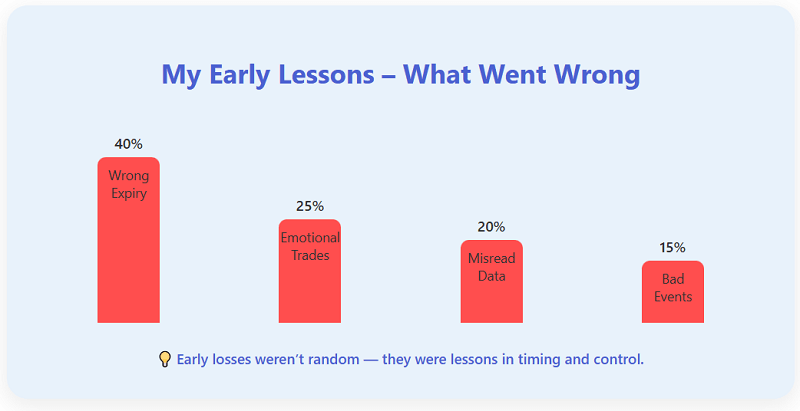
Understanding the Event–Expiry Connection
Eventually, I started treating expiry not as an afterthought but as the core of the setup. I began keeping detailed notes after each event, marking how long the main move lasted and when reversals typically occurred.
Here’s a summary from those logs:
| Event Type | Market Reaction Pattern | Expiry Window That Worked Best |
| Major Data (CPI, NFP) | Sharp move, fast reversal | 1–3 hours |
| Central Bank Decision | Volatility, multiple swings | 3–6 hours |
| Corporate Earnings | Slower, sustained trends | 1–2 days |
| Geopolitical News | Unpredictable, extended effects | 1–3 days |
That small exercise changed everything. I realized binary expiry wasn’t about convenience, it was about matching the life span of volatility.
So when I traded the next inflation report, I chose a 2-hour expiry instead of 15 minutes. The market spiked, paused, then continued higher. My trade expired during the second push instead of getting caught in the noise. That was the first time I felt in sync with market rhythm instead of racing against it.

The Trade That Changed My Perspective
There’s one particular day I still think about. It was during a Bank of England press conference. The base rate decision was expected to stay unchanged, but traders were nervous about the governor’s tone.
I waited for the rate release, no surprise there. But when the speech began, I noticed subtle hawkish language: mentions of inflation “remaining persistent.” The pound hesitated, then began to climb slowly.
I opened a binary contract with a four-hour expiry, long enough to let the speech sink in. For the first hour, nothing much happened. Then London traders started adjusting positions. The currency climbed steadily until expiry. It wasn’t dramatic, just steady.
That day taught me that news trades aren’t always about explosive spikes. Sometimes, the edge lies in patience, choosing an expiry that allows markets to digest the story.
Where Most Traders Misread the News
Over time, I noticed why most newcomers fail at binary options news trading. It’s not lack of knowledge; it’s misunderstanding how the market interprets information.
Most losses happen because:
- The market was already priced in expectations before the event.
- Expiry doesn’t match the reaction window.
- Traders mistake volatility for opportunity, when it’s often just noise.
It’s easy to think that every event creates instant profit potential. But often, the opposite is true, the more predictable the event, the less meaningful the movement. I started focusing only on events where the range of expectations was wide. Those were the ones that truly moved markets.
Inside My Trading Routine
Before every major event, I follow a simple process. I check three things:
- Consensus forecast – What does the market expect?
- Recent price action – Has the asset already adjusted for that expectation?
- Reaction window – Based on past data, how long does the move usually last?
Then I pick my expiry based on that last point. If I expect the move to unfold slowly, I’ll give it time. If I think it will spike and fade, I’ll shorten it.
For example, during corporate earnings, I’ve noticed that stocks often gap up or down immediately but keep trending for hours afterward. So instead of short expiries, I now pick ones that stretch across the next trading session.
It’s not perfect, but it’s consistent, and consistency beats prediction in this game.
A Tale of Two Trades
One of my biggest lessons came from two back-to-back trades during the same week.
Trade 1: U.S. Inflation Report
I predicted a strong number that would lift the dollar. I opened a 1-hour binary call. The number hit, the dollar spiked as expected, but reversed within 30 minutes as traders re-evaluated. My trade expired out of the money. Direction right, timing wrong.
Trade 2: Tech Stock Earnings
Two days later, a large tech company beat expectations and raised forecasts. I went long with a 24-hour expiry. The stock rose 3% after hours and another 2% next morning. My binary expired comfortably in profit.
Same trader, same week. The only difference was how I matched expiry with event type.
What the Internet Rarely Explains
When I searched “how to trade the news with binary options,” every article repeated the same lines, “trade high volatility events,” “watch economic calendars,” “manage risk.” None explained how expiry alignment decides outcomes.
So I filled that gap myself by tracking every expiry result for different event types. Here’s what stood out:
- Fast-moving events (like NFP or CPI) reward short expiries if you can catch the initial move.
- Complex events (central banks, speeches) need patience; their direction evolves.
- Corporate events behave differently, less spike, more sustained drift.
Most importantly, I saw that expiry mismatches, not bad direction calls, caused nearly 70% of my early losses. That statistic alone convinced me to treat timing as my real edge.
If you’d like to understand expiry setups better, you can check my earlier post on how expiry selection shapes strategy results (insert link here).
How I Manage Risk Now
Risk in binary trading is simple to define but tricky to live with. You either win the payout or lose the stake. Because of that, I limit myself to small, fixed amounts per trade, never more than one or two percent of capital.
Before every event, I also write a one-line “reason to stay out.” If that reason sounds stronger than my trading logic, I don’t trade. It keeps me disciplined.
Another personal rule: never trade multiple events back-to-back. After a big loss, I stop for the day. Emotional residue clouds expiry judgment faster than anything else.
How Events Truly Affect Expiry Results
After several hundred recorded trades, I noticed clear patterns in how events impact expiry outcomes:
- Anticipation phase: Prices often move before the event. Expiry timing that overlaps with this phase can ruin entries.
- Immediate release: Reaction speed varies by event. Some explode in seconds; others drift for hours.
- Interpretation period: After the data, markets digest context (like core vs headline figures). This period is where mismatched expiries usually fail.
- Resolution: True direction becomes clear only after noise settles. If expiry is set here, win rates improve dramatically.
I started planning expiries to overlap this fourth stage rather than the initial spike, and my consistency jumped.
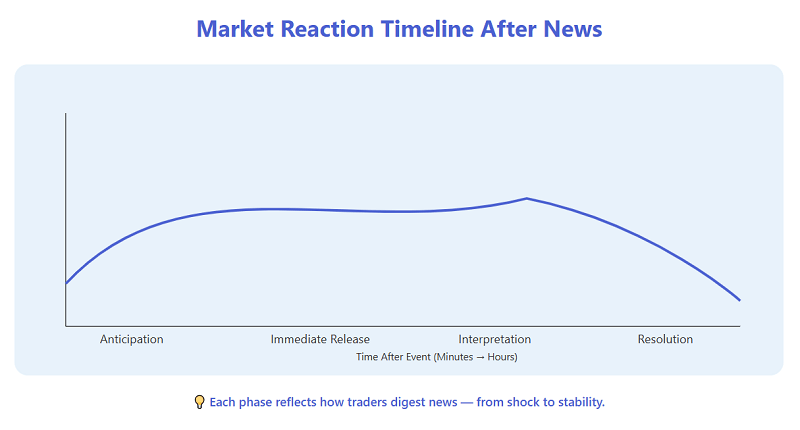
My Personal “Reaction Timing” Guide
Here’s a simplified version of my personal guide, built purely from observation:
| Event Type | Market Behaviour | My Go-To Expiry Range |
| Economic Data | Quick burst + short reversal | 1–2 hours |
| Policy Announcements | Slow realignment | 3–6 hours |
| Corporate Earnings | Gradual follow-through | 12–24 hours |
| Political/Geopolitical News | Extended uncertainty | 1–3 days |
If you look closely, the more complex the news, the longer the expiry I use. That’s not about patience, it’s about matching reaction time to event complexity.
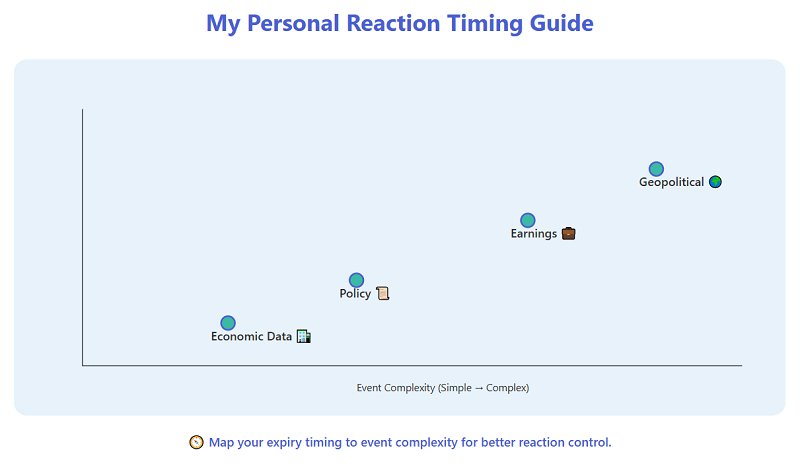
The Trades That Still Beat Me
I’d love to say I’ve mastered it, but I still lose, often for predictable reasons.
Sometimes the market reacts slower than I expect. Other times, the first move reverses completely before expiry. I’ve also had trades where the outcome was “mixed”, good headline, bad subtext, leaving direction unclear.
But losses aren’t the enemy; misunderstanding is. Every expiry that expires wrong teaches timing better than any tutorial ever could. I’d rather lose honestly with good logic than win by luck on a spike.
Lessons I Keep Coming Back To
After years of trial and error, I keep returning to a few simple truths about binary options news trading:
- The event matters less than how the market expected it.
- Expiry selection is a reflection of patience and realism.
- Avoid over-trading news, pick your spots carefully.
- Always journal. Without records, you’ll repeat the same expiry mistakes.
Those notes, more than any system, built my improvement curve.
If you’re new to binary options, start by keeping a simple spreadsheet of event type, expiry length, and outcome. After twenty trades, patterns emerge. That’s when you’ll really understand how expiry interacts with news. You can start that process easily on a free demo through our Pocket Option link.
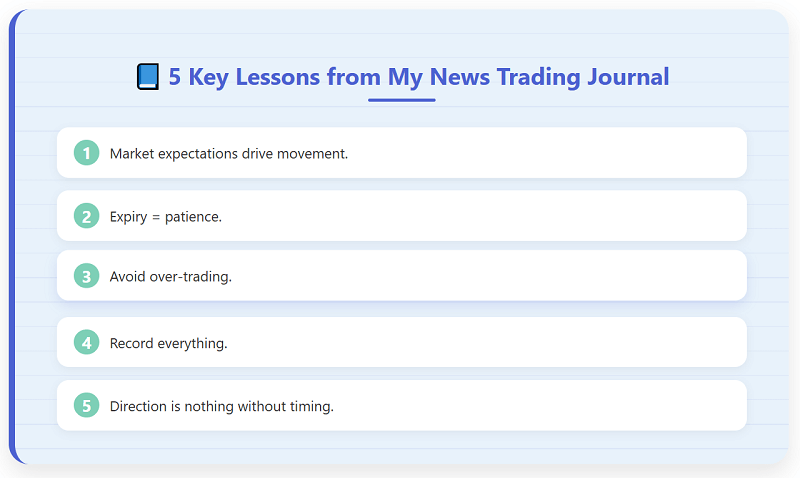
My Current Approach
These days, my setup looks very different from when I started. I split my trades into two groups:
- Short expiries (1–3 hours) around major data releases.
- Longer expiries (up to 2 days) for company earnings or central-bank decisions.
Before each trade, I write down: “What would surprise the market most?” That single question keeps me focused on expectation rather than headline.
Then I wait for confirmation, price action that shows the market reacting genuinely, not just spiking. Only then do I place the binary.
It’s a slower style, but far more controlled. Some days I don’t trade at all. I’ve learned that waiting for the right news-expiry alignment pays more than chasing constant action.
Final Thoughts: Why I Still Trade the News
There’s a certain adrenaline in watching the market react to real-world events, the moment a data point becomes a chart movement. But what keeps me in it isn’t the thrill; it’s the discipline it demands.
Binary options news trading has taught me more about patience and psychology than any technical indicator ever could. It forced me to accept that the market isn’t wrong, my timing often is.
These days, I don’t try to outsmart the market. I try to listen to its rhythm. News gives it a heartbeat; expiry defines its breathing pattern. My job is to synchronize with both.
🚀 The News-to-Expiry Flow
And if you want to feel that rhythm yourself, you can open an account here, start in demo mode, and see firsthand how expiry windows react to global events. Record everything. Because in the end, the data you gather from your own trades will be worth more than any article, mine included.